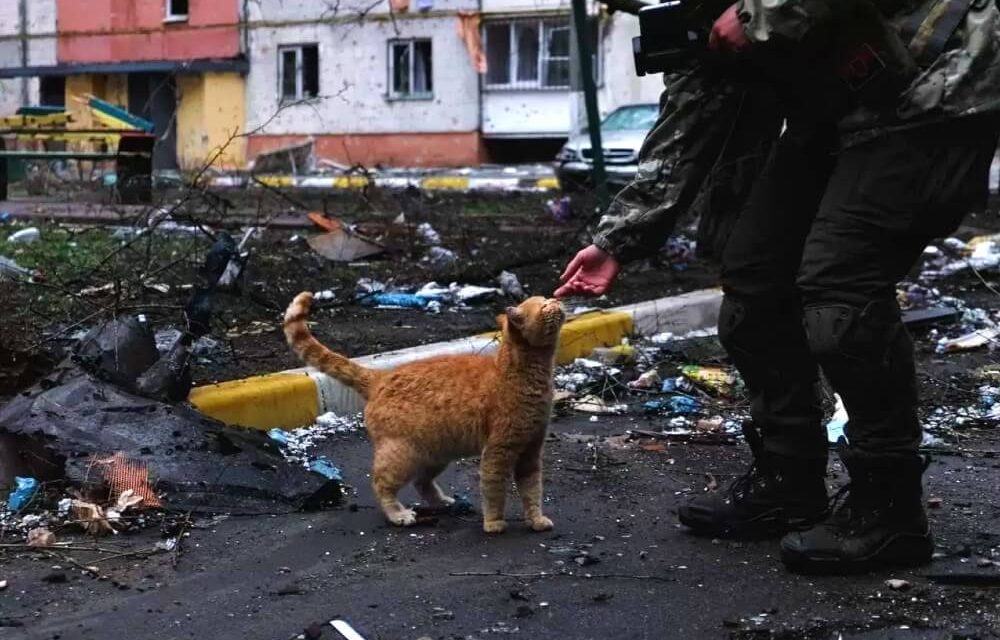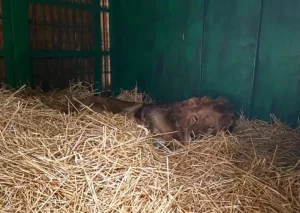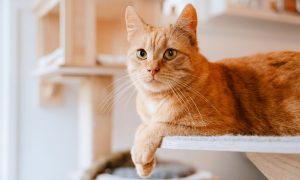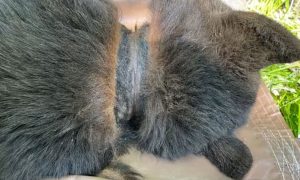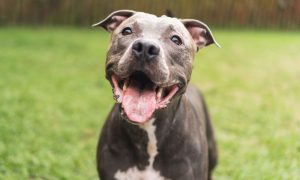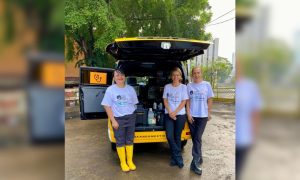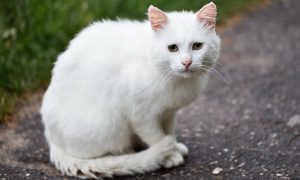As a now almost year-long war in Ukraine rages on, animal welfare advocates and rescuers with UAnimals are not only staying the course — they are ramping up their efforts to help.
Since the full-scale war started in February 2022, the nonprofit charity, founded in 2016, has shifted efforts toward rescuing animals from combat zones and temporarily-occupied territories.
Volunteers and staff are working tirelessly to rebuild bombed-out shelters, provide life-saving food and medications, and evacuate animals from war zones, UAnimals Chief Operating Officer Olga Chevganiuk told Lady Freethinker (LFT).
Evacuees include a surprising number of “pet” lions left by fleeing families and big cats in damaged or now inaccessible zoos, along with an unprecedented number of stray dogs and cats roaming the rubble-strewn streets. UAnimals also helped rescue cows, alpaca, wildlife, and farmed animals — including one memorable intake of a beloved goat.
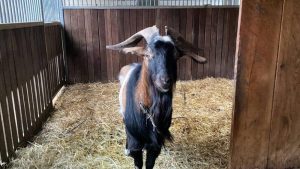
(Photo Credit: UAnimals)
Chevganiuk said a fleeing family trusted the care of the goat to a neighbor. When authorities declared the area safe, the family tried to return for the goat but ran into shelling. The neighbor could no longer care for the goat, so UAnimals stepped in.
With a core principle that “Every life is precious,” UAnimals even stepped in to help a swarm of bees.
The dangers of injury – and death — are still a very real threat that UAnimals rescuers face every day, Chevganiuk said.
“We do face the possibility of death all the time,” Chevganiuk said. “These people who go to the territories under shelling, that is something they are seeing. War is still here, and it’s not getting any easier.”
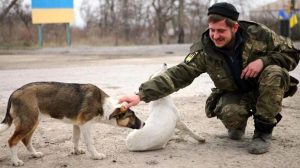
(Photo Credit: UAnimals)
RESCUING ANIMALS AND HELPING THEIR PEOPLE, TOO
The United Nations refugee agency reported that the Russian-Ukrainian war had displaced nearly 8 million now-refugees as of Jan. 26.
Meanwhile, for those who remain in Ukraine, winter is in full force — with freezing temperatures descending at a time when many residents and animal shelters are now without heat, running water, or electricity due to the war’s destruction.
Into this scarcity, UAnimals has distributed more than 500 tons of feed and forage for animals, along with desperately-needed medications, vitamins, and supplements.
Dedicated staff and volunteers have helped reconstruct 10 shelters, spayed or neutered more than 7,000 animals, and also evacuated more than 1,000 animals — including dogs, cats, birds, tigers, lions, wolves, horses, badgers, foxes, donkeys, sheep, goats, and lemurs.
It’s not easy work. It’s also not safe.
The tragic death of Ukrainian Anastasia Yalanska, who was shot to death reportedly by Russian forces while on her way to deliver supplies to an animal shelter in Bucha, made headlines in March 2022 and caused international outrage.
Danger of injury and death are still very real. Recently, a trailer bearing supplies veered slightly off the road and exploded upon contact with a buried mine, Chevganiuk said.
“We really appreciate the work of these dedicated people and what they are doing to save animals, who can’t help themselves,” she said. “It is very stressful, but this is our choice, to be here and to protect our land.”
More than 400 of those rescued animals — including several big cats — were evacuated abroad.
“Ukraine doesn’t have the kind of shelters to care for these animals,” Chevganiuk said. “What amazes me most of all is the number of big cats in captivity. Even almost a year into the war, we are still finding big cats that need rescuing. They are really in huge stress with the noise and the shellings.”
The UAnimals Wild Animal Rescue Center covered the costs of surgery for an evacuated lioness with a complicated birth, as well as the treatment of two evacuated lion cubs sent abroad.
Another lion, kept in a small enclosure as a “pet” and evacuated from the Sumy region of Ukraine, could not use his back legs or walk at the time of his rescue. He’s currently being rehabilitated at the UAnimals Wild Animal Rescue Center, and will be rehomed to a rehab center in Europe if he can fully recover, Newsweek reported.
Meanwhile, UAnimals is continuing their efforts to help rebuild destroyed shelters — when and where they can.
“We rebuild shelters in areas where we know they won’t be bombed the next day,” Chevganiuk said. “You fundraise, you find people, you find the best options, and then you do.”
Photo exhibits titled “Animals and War in Ukraine,” on display at The Hague in the Netherlands and also at Cornell University’s College of Veterinary Medicine in New York, also aim to inform people about the ongoing, tremendous suffering and survival of animals in Ukraine.
Russian shelling reportedly has destroyed at least 20 companion animal asylums, three zoos, and killed more than six million domestic animals, said UAnimals Activist Daria.
“We want the world to hear about those crimes, crimes which will be punished for sure,” she said.
SPEAKING UP ABOUT ECOCIDE
Ukraine, within a part of Europe dubbed the “Green Heart of Europe,” is home to more than 70,000 plant and animal species and 35 percent of Europe’s biodiversity, according to the World Wildlife Fund.
Another ongoing effort by UAnimals is not only to speak up for the animals but also for this earth — to witness and to demand accountability for the damage caused to the planet by the war.
The destruction of the natural environment by deliberate human action — also called “ecocide” — in Ukraine has included forests burned to the ground by rockets and projectiles, soil and land polluted and littered with remains of ammunition and toxic substances from bombed industrial facilities, and air pollution from hundreds of thousands of tons of petroleum burned during shelling, UAnimals said.
One estimate from the Stockholm International Peace Research Institute puts the costs of the environmental destruction at more than $46 billion — with the Ukrainian Ministry of Environmental Protection and Natural Resources reportedly verifying at least 2,215 incidents of disruption or destruction to critical infrastructure or industrial facilities like chemical plants.
Part of UAnimals’s effort to bear witness includes a video with photographs of the destruction overlaid by a song, “Carol of the Ecocide,” created in collaboration with renowned singer Tina Karol.
“War destroys life in the fullest meaning of the word,” Karol said. “It takes people’s lives, wrecks their homes and their way of life, poisons the land, and buries people’s hopes along with the right for the pursuit of happiness.”
But both Karol and Chevganiuk pulled strength from Ukrainian resilience and compassion in the face of great adversity.
“Ukraine is a symbol of the human miracle of resilience and indomitability, a miracle that defends the whole world in this destructive war,” Karol said.
Chevganiuk added, “It’s one thing to talk about being humane during normal times, but even more especially during a war. The Ukrainian army has done so much for animals.”
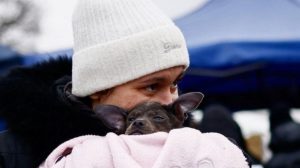
(Photo Credit: UAnimals)
How You Can Help
Chevganiuk said Westerners can help UAnimals in their efforts by donating to their active “Survive the Winter” fundraisers or to their efforts as a whole through their Patreon account.
People also can help by using their social media platforms to spread awareness about the ongoing war in Ukraine and the brutal realities for animals and people there, she added.
To learn more about UAnimals, you can visit their website here.

